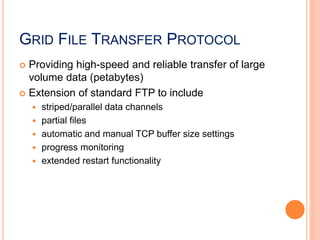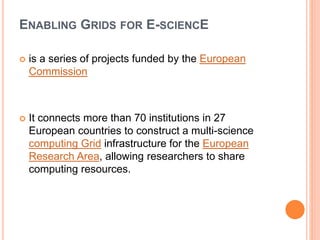Grid Computing
- 1. GRID COMPUTING Presented By : GAJENDRA SINGH RAWAT ROLL NO--CSI10016 RANJAN PATOWARY ROLL NO--CSI10018 MTECH(IT)
- 2. PRESENTATION OVERVIEW INTRODUCTION TYPES OF GRID COMPUTING NEED FOR GRID COMPUTING METHODS OF GRID COMPUTING GRID ARCHITECTURE MODEL EXISTING WORKS OF GRID COMPUTING GRID COMPUTING IN FUTURE REFERENCES
- 3. INTRODUCTION Grid computing is applying the resources of many computers in a network to a single problem, also at the same time to a scientific or technical problem that requires a great number of computer processing cycles or access to large amounts of data. Grid Computing enables virtual organizations to share geographically distributed resources as they pursue common goals, assuming the absence of central location, central control, omniscience, and an existing trust relationship.” – Globus Alliance
- 5. TYPES OF GRID COMPUTING Computational grid : This grid is used to allocate resources specifically for computing power . Scavenging grids : It is use to find and harvest machine cycles from idle servers and desktop computers for use in resource-intensive tasks. Data grids : It provide a unified interface for all data repositories in an organization, and through which data can be queried, managed and secured
- 6. GRID CHARACTERISTICS Resources that are connected via a network are geographically distributed may consist of heterogeneous hardware and/or software are managed transparently for performance and fault tolerance Creates the illusion of virtual organizations and projects without the presence of a central authority, or a central control Explicit trust relationships between users and resources A system that scales in space and time
- 7. TYPES OF RESOURCES Computation utilization of computing cycles found on processors of the machines on the grid Storage to increase capacity, performance, sharing, and reliability of data Communication to increase capacity, performance, and reliability of data communication Collaboration tools to facilitate collaboration through conferencing, visualization, and data sharing Software and Licenses to share site-specific software and/or licenses Special equipment, capacities, architectures, and policies printers, imaging, sensors, or other local specialty resources
- 9. GRID TOPOLOGIES Departmental Grids localized to a specific group of people generally, same hardware and software designed for high throughput and high performance over a dedicated network Enterprise Grids service to numerous groups within a single company or campus resource heterogeneity increases company-wide local area network Extraprise Grids service to multiple companies, partners, and customers within a particular domain domain based private network Global Grids established over the public-Internet
- 10. RESOURCE-BASED GRIDS Compute Grids desktop nodes server nodes high-performance computing clusters Data Grids performance-based distributed storage replication for fault-tolerance Collaboration Grids support for video-conferencing, visualization and data sharing Utility Grids maintained and managed by a commercial service provider compute resources acquired on a per-need basis application resources that are purchased on a per-use or per- minute basis
- 11. NEED FOR GRID COMPUTING Current distributed computing technologies, Internet technologies address communication and information exchange among computers but do not support coordinated use of resources at multiple sites for computation. Enterprise distributed computing technologies such as CORBA and Enterprise Java enable resource sharing within a single organization The concept that underlies the Grid is coordinated resource sharing and problem solving in multi-institutional virtual organizations. The sharing that we are concerned with is not primarily file exchange but direct access to computers, software, data and other resources. This sharing is, necessarily, highly controlled, with resource providers and consumers defining clearly and carefully just what is shared, who is allowed to share, and the conditions under which sharing occurs.
- 12. METHODS OF GRID COMPUTING Distributed Supercomputing High-Throughput Computing On-Demand Computing Data-Intensive Computing Collaborative Computing Logistical Networking
- 13. CONTINUE.. Distributed Supercomputing Combining multiple high-capacity resources on a computational grid into a single, virtual distributed supercomputer. Tackle problems that cannot be solved on a single system. High-Throughput Computing Uses the grid to schedule large numbers of loosely coupled or independent tasks, with the goal of putting unused processor cycles to work On-Demand Computing Uses grid capabilities to meet short-term requirements for resources that are not locally accessible. Models real-time computing demands. Data-Intensive Computing
- 14. CONTINUE.. The focus is on synthesizing new information from data that is maintained in geographically distributed repositories, digital libraries, and databases. Particularly useful for distributed data mining. Collaborative Computing Concerned primarily with enabling and enhancing human-to-human interactions. Applications are often structured in terms of a virtual shared space. Logistical Networking Global scheduling and optimization of data movement. Contrasts with traditional networking, which does not explicitly model storage resources in the network. Called "logistical" because of the analogy it bears with the systems of warehouses, depots, and distribution channels.
- 15. GRID ARCHITECTURE MODEL (THE GLOBUS VIEW) Software stack consisting of Standards Protocols APIs and SDKs Loosely based on the Internet model
- 16. A DETAILED VIEW… Fabric – protocols and interfaces to resource being shared Connectivity – protocols for grid-specific network transactions (IP, DNS, WSDL); Security implementation (GSI) Resource – protocols to initiate and control sharing of local resources (GRAM, GridFTP, GRIS) Collective – protocols for system-wide deployment (versus local) Application – protocols targeted at a specific application or class of applications
- 17. GRID PROTOCOLS Grid Security Infrastructure (GSI) Grid Resource Allocation and Management (GRAM) Grid File Transfer Protocol (GridFTP) Grid Information Services (GIS)
- 18. GRID SECURITY INFRASTRUCTURE Extended from SSL/TLS and X.509 protocols Utilizes PKI for Certificate Authority Primary objective is “Authorization” Generates primary credential Generates temporary proxy credential Certificate Authority Positively identify entities requesting certificates Issuing, removing, and archiving certificates Protecting the Certificate Authority server Maintaining a namespace of unique names for certificate owners Serve signed certificates to those needing to authenticate entities Logging activity
- 19. PUBLIC KEY INFRASTRUCTURE 1. User A encrypts message with his private key 2. Obtains User B’s public key from CA 3. Encrypts message with B’s public key 4. Sends message 1. User B decrypts message with his private key 2. Obtains User A’s public key from CA 3. Decrypts A’s message with public key 4. B knows message is from A Publi c Priva te Priva te Publi c Public Keys “A” “B” Certificate Authority B’s public key A’s public key Authentication Credential
- 21. GRID RESOURCE ALLOCATION AND MANAGEMENT Allows programs to be started on remote resources Resource Specification Language (RSL) Resource requirements machine type, number of nodes, memory, etc… Job configuration directory, executable, arguments, environment Communication protocols HTTP-base RPC (early protocol) Web-services (WSDL, SOAP) “create 5-10 instances of myprog, each on a machine with at least 64MB memory that is available to me for 4 hours, or 10 instances, on a machine with at least 32MB of memory”
- 22. GRID FILE TRANSFER PROTOCOL Providing high-speed and reliable transfer of large volume data (petabytes) Extension of standard FTP to include striped/parallel data channels partial files automatic and manual TCP buffer size settings progress monitoring extended restart functionality
- 23. GRID INFORMATION SERVICES Grid Resource Information Service (GRIS) provides resource specific information Grid Resource Registration (GRR) updates GRIS about resource status Grid Index Information Service (GIIS) an aggregate directory service provides a collection of information that has been gathered from multiple GRIS servers Grid Resource Inquiry (GRI) queries GRIS server for resource information queries GIIS server for information
- 24. OPEN GRID SERVICES ARCHITECTURE Marriage of grid protocols with web service protocols Specifications for How Grid Services are created and discovered How Grid Service instances are named and referenced Interfaces that define any Grid Service Initial release with GT 3.0 mid-2003; GT 4.0 Jan 2005
- 26. SETI@HOME PROJECT SETI is an acronym for the Search for Extra- Terrestrial Intelligence. is an internet-based public volunteer computing project One of the most famous cycle-scavenging networks, which was using more than 3 million computers to achieve 23.37 sustained teraflops
- 27. ENABLING GRIDS FOR E-SCIENCE is a series of projects funded by the European Commission It connects more than 70 institutions in 27 European countries to construct a multi-science computing Grid infrastructure for the European Research Area, allowing researchers to share computing resources.
- 28. BEINGRID (BUSINESS EXPERIMENTS IN GRID) is a research project partly funded by the European Commission Started on June 1 2006, the project was run 42 months, till December 2009 their mission is "to establish effective routes to foster the adoption of Grid Computing across the EU and to stimulate research into innovative business models using Grid technologies."
- 29. DISTRIBUTED.NET Also known as Distributed Computing Technologies, Inc. or DCTI started in 1997 is a worldwide distributed computing effort that is attempting to solve large scale problems using otherwise idle CPU
- 30. WORLD COMMUNITY GRID mission is to create the largest public computing grid that benefits humanity This work is built on belief that technological innovation combined with visionary scientific research and large-scale volunteerism can change our world for the better.
- 32. SEMANTIC GRID Grid Service + Ontology + Knowledge Driven Services The semantic web is an extension of the current Web. # information is given a well-defined meaning, better enabling computers and people to work in cooperation
- 33. Semantic Grid has the idea of having data on the Web defined and linked in a way that can be used for 1. more effective discovery, 2. automation, 3.integration and 4.reuse across various applications. o The web can reach its full potential if it becomes a place where data can be processed by automated tools as well as people.
- 34. AUTONOMIC GRID The increasing system complexity is reach a level beyond human ability to design, manage and secure Programming environments and infrastructure are becoming unmanageable, brittle and insecure One solution is Autonomic Grid application which are context aware and capable of self-configuring, self-composing, self-optimizing and self-adapting.
- 35. REFERENCES [1] http://www.google.com [2] http://www.gridcomputing.com [3] http://en.wikipedia.org [4] ] Ihssan Alkadi, Grid Computing: The Trend Of The Millenium
- 36. THANK YOU


































![REFERENCES
[1] http://www.google.com
[2] http://www.gridcomputing.com
[3] http://en.wikipedia.org
[4] ] Ihssan Alkadi, Grid Computing: The Trend
Of The Millenium](https://image.slidesharecdn.com/csi1001618-101125034017-phpapp01/85/Grid-Computing-35-320.jpg)
